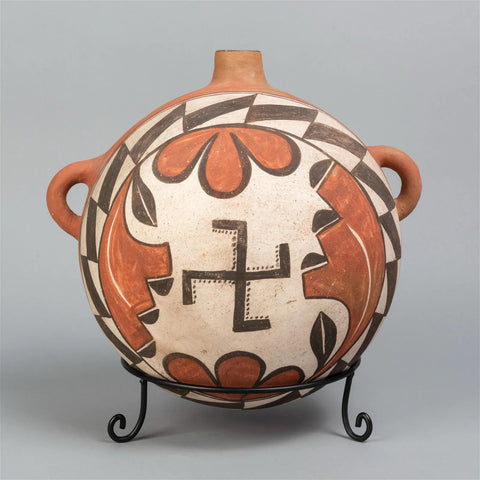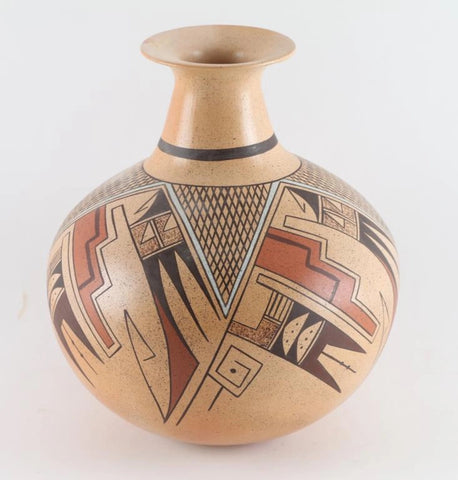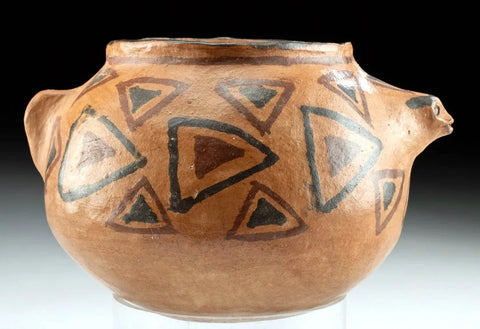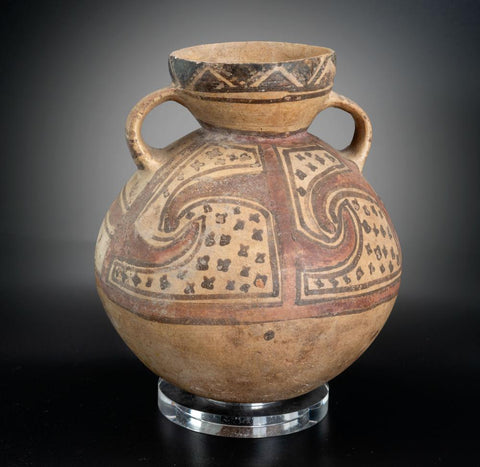
Native American, Vintage Hopi Wedding Vase, by K. Collateta, Ca 1900's, #1402
$ 1,000.00
Native American, Vintage Hopi Wedding Vase, by K. Collateta, Ca 1900's, #1442
Description: #1442 Native American, Vintage Hopi Wedding Vase, by K. Collateta, Ca 1900's. Wonderful, original design double-necked vase with both traditional and contemporary poly chrome designs.
Condition: Very good condition, minor surface scratches.
Dimensions: 8" x 5"
Kathleeen Collateta Sandia, also signs K. Collateta. Active from 1975-present: black and red on yellow seed jars and vases, black and red on white jars, wedding vases, bowls. Grand daughter in law of Sara Collateta, Favorite designs include: bird, rain, clouds, Mudheads, feathers, parrot, Polik Mana Butterfly Maiden, Dawa-Sun Kachina. Born in 1969, Kathleen Collateta is a member of the Sun Clan at Jemez Pueblo. Her mother, Antonita Collateta, is from Jemez and well known for her traditional embroidery on dance costumes. Her father, Tom Collateta Sr. is Hopi-Tewa and a well known Kachina carver from First Mesa. Kathleen makes her living as a potter, working with her husband Adrian Sandia at Jemez Pueblo. They are also teaching their children to make pottery the traditional way.
Beginning in 1985, Kathleen began learning from her grandmother, Sarah Collateta, who showed her the intricacies of many ancient Jemez designs as well as techniques for drawing and painting them. Kathleen taught herself to mold and shape her pots in many different styles which she hand coils of clay she digs at Hopi. She paints with natural pigments: the black paint is made from boiled-down wild spinach mixed with a black rock she grinds to powder. She also fires her pottery outdoors in the traditional way.
Her favorite design is the parrot, which represents male and female (groom and bride) and is usually enhanced with the feather designs which represent all birds. "The birds take our prayers up to the higher spirit," she says.
Kathleen tells us she loves to make pottery: it makes her happy to know that someone will have a piece of hers in their home as a valued possession.
She was published in the summer 1995 edition of The Messenger (Wheelwright Museum) and featured in Hopi-Tewa Pottery: 500 Artists (Schaaf). Kathleen won Best of Show at New Mexico State Fair in 2004. ( Source: Andrea Fisher Fine Pottery)
“Pueblo pottery is made using a coiled technique that came into northern Arizona and New Mexico from the south, some 1500 years ago. In the four-corners region of the US, nineteen pueblos and villages have historically produced pottery. Although each of these pueblos use similar traditional methods of coiling, shaping, finishing and firing, the pottery from each is distinctive. Various clays gathered from each pueblo’s local sources produce pottery colors that range from buff to earthy yellows, oranges, and reds, as well as black. Fired pots are sometimes left plain and other times decorated—most frequently with paint and occasionally with applique. Painted designs vary from pueblo to pueblo, yet share an ancient iconography based on abstract representations of clouds, rain, feathers, birds, plants, animals and other natural world features.
Tempering materials and paints, also from natural sources, contribute further to the distinctiveness of each pueblo’s pottery. Some paints are derived from plants, others from minerals. Before firing, potters in some pueblos apply a light colored slip to their pottery, which creates a bright background for painted designs or simply a lighter color plain ware vessel. Designs are painted on before firing, traditionally with a brush fashioned from yucca fiber.
Different combinations of paint color, clay color, and slips are characteristic of different pueblos. Among them are black on cream, black on buff, black on red, dark brown and dark red on white (as found in Zuni pottery), matte red on red, and poly chrome—a number of natural colors on one vessel (most typically associated with Hopi). Pueblo potters also produce undecorated polished black ware, black on black ware, and carved red and carved black wares.
Making pueblo pottery is a time-consuming effort that includes gathering and preparing the clay, building and shaping the coiled pot, gathering plants to make the colored dyes, constructing yucca brushes, and, often, making a clay slip. While some Pueblo artists fire in kilns, most still fire in the traditional way in an outside fire pit, covering their vessels with large potsherds and dried sheep dung. Pottery is left to bake for many hours, producing a high-fired result.
Today, Pueblo potters continue to honor this centuries-old tradition of hand-coiled pottery production, yet value the need for contemporary artistic expression as well. They continue to improve their style, methods and designs, often combining traditional and contemporary techniques to create striking new works of art.” (Source: Museum of Northern Arizona)
Description: #1442 Native American, Vintage Hopi Wedding Vase, by K. Collateta, Ca 1900's. Wonderful, original design double-necked vase with both traditional and contemporary poly chrome designs.
Condition: Very good condition, minor surface scratches.
Dimensions: 8" x 5"
Kathleeen Collateta Sandia, also signs K. Collateta. Active from 1975-present: black and red on yellow seed jars and vases, black and red on white jars, wedding vases, bowls. Grand daughter in law of Sara Collateta, Favorite designs include: bird, rain, clouds, Mudheads, feathers, parrot, Polik Mana Butterfly Maiden, Dawa-Sun Kachina. Born in 1969, Kathleen Collateta is a member of the Sun Clan at Jemez Pueblo. Her mother, Antonita Collateta, is from Jemez and well known for her traditional embroidery on dance costumes. Her father, Tom Collateta Sr. is Hopi-Tewa and a well known Kachina carver from First Mesa. Kathleen makes her living as a potter, working with her husband Adrian Sandia at Jemez Pueblo. They are also teaching their children to make pottery the traditional way.
Beginning in 1985, Kathleen began learning from her grandmother, Sarah Collateta, who showed her the intricacies of many ancient Jemez designs as well as techniques for drawing and painting them. Kathleen taught herself to mold and shape her pots in many different styles which she hand coils of clay she digs at Hopi. She paints with natural pigments: the black paint is made from boiled-down wild spinach mixed with a black rock she grinds to powder. She also fires her pottery outdoors in the traditional way.
Her favorite design is the parrot, which represents male and female (groom and bride) and is usually enhanced with the feather designs which represent all birds. "The birds take our prayers up to the higher spirit," she says.
Kathleen tells us she loves to make pottery: it makes her happy to know that someone will have a piece of hers in their home as a valued possession.
She was published in the summer 1995 edition of The Messenger (Wheelwright Museum) and featured in Hopi-Tewa Pottery: 500 Artists (Schaaf). Kathleen won Best of Show at New Mexico State Fair in 2004. ( Source: Andrea Fisher Fine Pottery)
“Pueblo pottery is made using a coiled technique that came into northern Arizona and New Mexico from the south, some 1500 years ago. In the four-corners region of the US, nineteen pueblos and villages have historically produced pottery. Although each of these pueblos use similar traditional methods of coiling, shaping, finishing and firing, the pottery from each is distinctive. Various clays gathered from each pueblo’s local sources produce pottery colors that range from buff to earthy yellows, oranges, and reds, as well as black. Fired pots are sometimes left plain and other times decorated—most frequently with paint and occasionally with applique. Painted designs vary from pueblo to pueblo, yet share an ancient iconography based on abstract representations of clouds, rain, feathers, birds, plants, animals and other natural world features.
Tempering materials and paints, also from natural sources, contribute further to the distinctiveness of each pueblo’s pottery. Some paints are derived from plants, others from minerals. Before firing, potters in some pueblos apply a light colored slip to their pottery, which creates a bright background for painted designs or simply a lighter color plain ware vessel. Designs are painted on before firing, traditionally with a brush fashioned from yucca fiber.
Different combinations of paint color, clay color, and slips are characteristic of different pueblos. Among them are black on cream, black on buff, black on red, dark brown and dark red on white (as found in Zuni pottery), matte red on red, and poly chrome—a number of natural colors on one vessel (most typically associated with Hopi). Pueblo potters also produce undecorated polished black ware, black on black ware, and carved red and carved black wares.
Making pueblo pottery is a time-consuming effort that includes gathering and preparing the clay, building and shaping the coiled pot, gathering plants to make the colored dyes, constructing yucca brushes, and, often, making a clay slip. While some Pueblo artists fire in kilns, most still fire in the traditional way in an outside fire pit, covering their vessels with large potsherds and dried sheep dung. Pottery is left to bake for many hours, producing a high-fired result.
Today, Pueblo potters continue to honor this centuries-old tradition of hand-coiled pottery production, yet value the need for contemporary artistic expression as well. They continue to improve their style, methods and designs, often combining traditional and contemporary techniques to create striking new works of art.” (Source: Museum of Northern Arizona)
Related Products
Sold out




